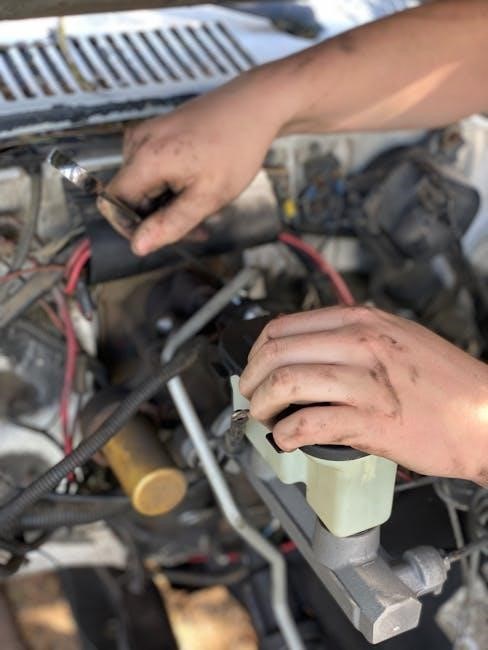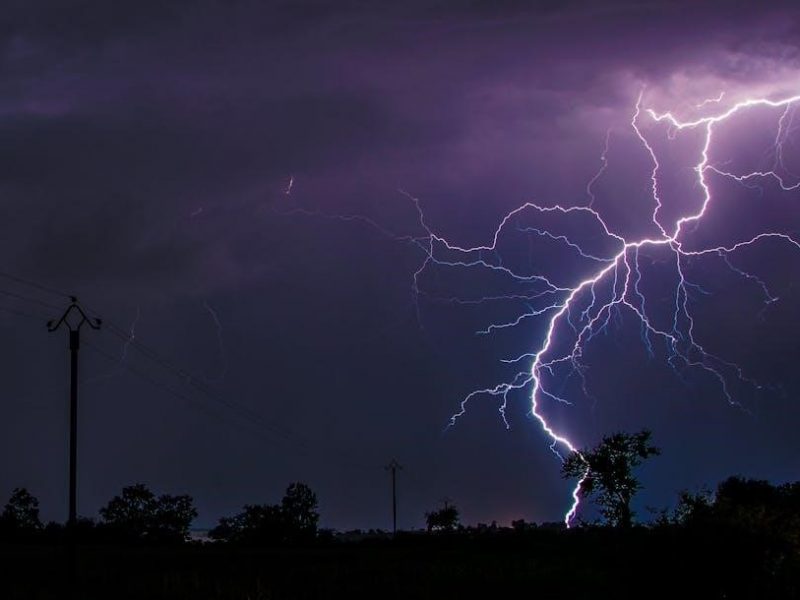A 3-phase motor starter wiring diagram is a detailed guide for connecting electrical components. It ensures safe and proper installation‚ operation‚ and troubleshooting of motor systems.
1.1 Importance of Wiring Diagrams in Motor Installation
Wiring diagrams are essential for installing 3-phase motor starters‚ ensuring correct connections and safe operations. They provide a clear visual guide‚ reducing installation errors and enhancing safety. Diagrams help technicians understand component relationships‚ facilitating troubleshooting and maintenance. Proper wiring prevents motor damage‚ ensures optimal performance‚ and complies with electrical standards. Without a diagram‚ installations may fail‚ risking equipment damage or safety hazards. Always refer to the specific wiring diagram provided with the motor or starter for accurate setup and compliance with manufacturer guidelines.
1.2 Brief Overview of 3-Phase Motor Starters
A 3-phase motor starter is a control system that manages the power supply to an industrial motor. It ensures smooth starting‚ running‚ and stopping of the motor while protecting it from overloads. The starter typically includes a contactor‚ overload relay‚ and control buttons. It operates by controlling the flow of electrical power to the motor windings‚ allowing for safe and efficient operation. The starter is crucial for maintaining motor performance and preventing damage from voltage spikes or excessive current. Proper installation‚ as guided by wiring diagrams‚ is essential for reliable operation.

Components of a 3-Phase Motor Starter
A 3-phase motor starter consists of key components like contactors‚ overload relays‚ and control buttons‚ ensuring safe and efficient motor operation by regulating power supply and protecting against overloads.
2.1 Contactors and Their Role
Contactors are essential electromagnetic switches in 3-phase motor starters. They are responsible for connecting and disconnecting the power supply to the motor‚ enabling smooth start and stop operations. By controlling the flow of electrical current‚ contactors protect the motor from sudden voltage spikes and ensure safe switching. Proper wiring of contactors‚ as shown in diagrams‚ is crucial for maintaining the motor’s performance and preventing electrical hazards. They are often equipped with auxiliary contacts for additional control functions‚ enhancing system flexibility and safety.
2.2 Overload Relays and Protection
Overload relays are critical components in 3-phase motor starters‚ protecting motors from damage caused by overcurrent or overheating. They monitor the current flowing through the motor and disconnect the power supply if it exceeds safe levels. Properly wired overload relays‚ as shown in diagrams‚ ensure motor longevity and prevent electrical hazards. Thermal overload relays are commonly used‚ tripping when excessive heat is generated due to prolonged overloads. Correct settings and wiring are essential to avoid false trips or equipment damage.
2.3 Start/Stop Control Buttons
Start/stop control buttons are essential components in 3-phase motor starter systems‚ enabling manual control of motor operations. These buttons are typically wired in the control circuit‚ providing a safe and straightforward way to initiate or halt motor functions. The start button energizes the contactor‚ while the stop button de-energizes it‚ ensuring the motor ceases operation. Proper wiring of these buttons‚ as detailed in diagrams‚ is crucial for reliable performance and operator safety‚ preventing unintended startups or shutdowns during industrial processes.
2.4 Circuit Breakers or Fuses
Circuit breakers or fuses are critical protective devices in 3-phase motor starter systems. They safeguard the motor and starter from short circuits and overloads by interrupting the power supply during faults. Fuses provide simple‚ cost-effective protection‚ while circuit breakers allow for manual resetting without replacement. Proper wiring of these devices ensures reliable operation and prevents damage to the system. Selecting the correct rating is essential to match the motor’s specifications‚ ensuring optimal protection and performance under various operating conditions.
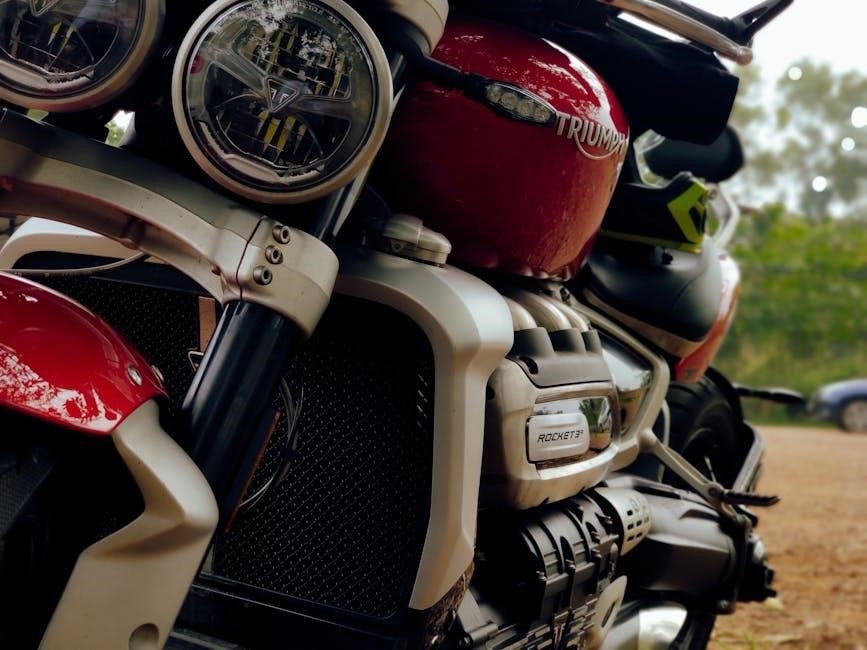
Types of 3-Phase Motor Starters
Three-phase motor starters include Direct-On-Line (DOL)‚ Star-Delta‚ Soft Starters‚ and Auto Transformer types‚ each offering unique advantages for motor control and protection in industrial applications.

3.1 Direct-On-Line (DOL) Starters
Direct-On-Line (DOL) starters are the simplest method for starting 3-phase motors; They involve connecting the motor directly to the power supply through a contactor and overload relay. The wiring diagram illustrates the connections between the power supply‚ contactor‚ overload relay‚ and motor. This configuration is suitable for applications requiring high starting currents but does not need speed control. DOL starters are commonly used in industrial settings for their reliability and straightforward installation.
3.2 Star-Delta (Y-Δ) Starters
Star-Delta (Y-Δ) starters are used to reduce the voltage during motor startup‚ lowering the starting current. They connect the motor windings in a star configuration during startup and switch to a delta configuration for full operation. This method is ideal for applications requiring reduced starting torque. The wiring diagram shows the connections between the power supply‚ contactors‚ and motor windings‚ ensuring proper phase switching. It is widely used in industrial settings for motors requiring soft starting capabilities without high starting current spikes.
3.3 Soft Starters
Soft starters are electronic devices that regulate voltage to a motor during startup and stop‚ reducing inrush current and mechanical stress. They use thyristors to gradually increase voltage‚ providing a smooth start and stop. Unlike DOL or Star-Delta starters‚ soft starters offer precise control over acceleration and deceleration. The wiring diagram for soft starters includes connections to the power supply‚ motor windings‚ and control circuits. This setup is ideal for applications requiring reduced voltage starts‚ such as pumps or conveyors‚ to minimize wear and improve energy efficiency.
3.4 Auto Transformer Starters
Auto transformer starters use an auto-transformer to reduce the voltage supplied to the motor during startup‚ minimizing inrush current and torque. The wiring diagram includes multiple taps on the transformer to adjust the starting voltage. This method is efficient for applications requiring variable speed control. However‚ auto transformer starters are less commonly used due to their larger size and higher cost compared to other starters like DOL or soft starters.

Understanding the Wiring Diagram
A wiring diagram is a visual guide showing connections between components like contactors‚ overload relays‚ and motor windings. It ensures safe and efficient system installation and operation.
4.1 Main Power Supply Connections
The main power supply connections are crucial for a 3-phase motor starter. They involve connecting the incoming power lines (R‚ S‚ T) to the contactor and overload relay. Proper wiring ensures the motor receives the correct voltage and current. The supply lines must be securely attached to the terminals‚ and all connections should follow the manufacturer’s specifications. Safety precautions‚ such as using appropriate gauge wires and ensuring tight connections‚ prevent overheating and ensure reliable operation. Always refer to the wiring diagram for specific configurations. Use of lockout/tagout procedures is essential for safety during installation and maintenance. This step is fundamental to the overall functionality and safety of the motor starter system.
4.2 Motor Windings and Phase Connections
Motor windings and phase connections are critical for proper 3-phase motor operation. The motor windings must be connected in either a star (Y) or delta (Δ) configuration‚ depending on the application. The starter wiring diagram specifies how the phases (R‚ S‚ T) connect to the motor terminals (U‚ V‚ W). Incorrect connections can lead to motor malfunction or damage. Always verify the motor’s nameplate for recommended configurations. The starter ensures the motor receives the correct voltage and current‚ optimizing performance and protection. Proper phase sequencing is essential for smooth operation. Refer to the wiring diagram for precise connections to avoid errors. Testing continuity ensures all phases are correctly linked‚ preventing startup issues. This step ensures the motor operates efficiently and safely under all conditions.
4.3 Control Circuit Wiring
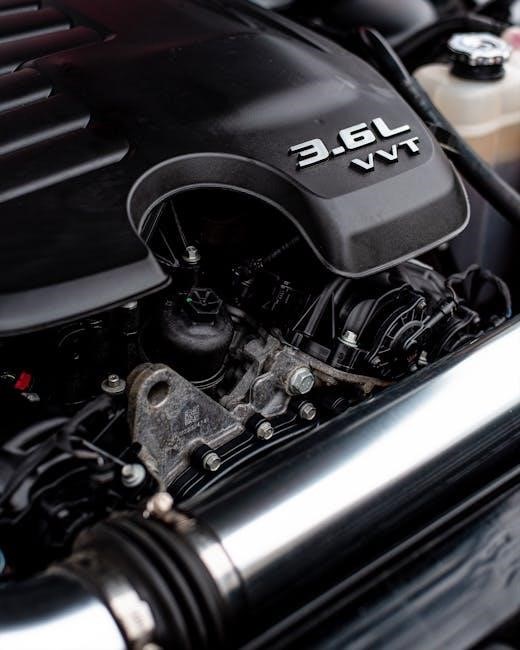
Control circuit wiring manages the motor’s operation through start/stop commands and safety interlocks. It typically includes push buttons‚ auxiliary contacts‚ and control relays. The circuit operates at a lower voltage (e.g.‚ 24V DC or 115V AC) to ensure safe operation. Proper wiring ensures seamless communication between control devices and the motor starter. Auxiliary contacts in the contactor provide feedback and interlock functions‚ preventing unsafe operations. The wiring diagram specifies connections for control power‚ ensuring reliable motor control and protection. Always follow the diagram to avoid errors and ensure smooth operation. Safety interlocks prevent unintended motor starts. Proper control wiring is essential for system reliability and safety.
4.4 Safety Interlocks and Auxiliary Contacts
Safety interlocks and auxiliary contacts are crucial for preventing unsafe operations. Auxiliary contacts provide feedback‚ ensuring the starter operates correctly. They control power supply continuity and monitor the motor’s status. Safety interlocks prevent simultaneous start/stop commands‚ avoiding electrical hazards. These components are wired to ensure the motor stops if a fault occurs. The wiring diagram details their connections‚ ensuring failsafe operation. Proper installation enhances system reliability and protects against potential dangers‚ making auxiliary contacts and interlocks essential for safe motor control and operation.

Safety Precautions and Best Practices
Adhering to safety practices is essential when working with 3-phase motor starters. Always use PPE‚ follow lockout/tagout procedures‚ and ensure overload protection settings are correct to prevent accidents and ensure reliable operation.
5.1 Personal Protective Equipment (PPE)
Using proper PPE is critical when working with 3-phase motor starters. This includes safety glasses‚ insulated gloves‚ and protective clothing to prevent electrical shocks and injuries. Ensure all PPE meets industry standards. Hard hats and steel-toe boots are also recommended for added safety in industrial settings. Always de-energize the system before starting work. PPE is essential for protecting against arc flashes and electrical hazards‚ even for experienced professionals. Adhering to safety practices is non-negotiable when handling high-voltage systems.
5.2 Lockout/Tagout Procedures
Lockout/Tagout (LOTO) procedures are essential for ensuring safety during maintenance of 3-phase motor starters. This process involves disconnecting power sources and securing them with locks or tags to prevent accidental energization. Always follow OSHA guidelines and use approved devices. Ensure all energy sources are isolated and verify zero energy state before starting work. Tags should be clearly labeled and understood by all personnel. Proper LOTO ensures the safety of technicians and prevents electrical accidents during repairs or inspections.
5.3 Overload Protection Settings
Overload protection settings are critical to safeguard 3-phase motor starters from damage caused by excessive current. Proper configuration ensures the motor operates within safe limits. Settings should be based on the motor’s full-load current‚ voltage‚ and duty cycle. Always refer to the manufacturer’s guidelines for accurate calculations. Testing the overload settings before commissioning ensures reliability. Use correctly rated circuit breakers or fuses to protect against short circuits. Regular maintenance and updates to settings prevent potential failures and extend equipment lifespan.

Common Wiring Configurations
Common wiring configurations include DOL‚ Star-Delta‚ and combination starters. Each setup ensures efficient motor control‚ with DOL being the simplest for direct power connection and high torque.
6.1 DOL Starter Wiring for 3-Phase Motors
A Direct-On-Line (DOL) starter is the simplest wiring configuration for 3-phase motors. It directly connects the motor to the power supply‚ ensuring high starting torque. The DOL starter includes a contactor‚ overload relay‚ and start/stop buttons. Wiring involves connecting the main power supply to the contactor‚ which then powers the motor windings. This configuration is ideal for applications requiring quick startups. Safety features like overload protection are essential. Always follow the wiring diagram for proper connections and ensure all components are rated for the motor’s specifications to avoid damage or hazards during operation.
6.2 Star-Delta Starter Wiring Diagram
The Star-Delta starter reduces voltage during motor startup‚ minimizing inrush current. It uses two contactors: one for the star connection and another for the delta. The motor windings are connected in a star configuration during startup and then switched to delta for full operation. A timer controls the switching between the two modes. This method is ideal for applications requiring reduced starting torque; The wiring diagram ensures proper connections for the contactors‚ overload protection‚ and control circuit. Always follow the diagram to prevent motor damage and ensure safe operation.
6.3 Combination Starters with Thermal Overload
Combination starters integrate a contactor‚ thermal overload relay‚ and circuit breaker or fuses in one enclosure. They provide motor protection and control in a compact design. The wiring diagram shows the main power supply connected to the breaker‚ with output to the contactor and motor. Thermal overload relays protect against excessive current‚ tripping if motor current exceeds safe levels. Auxiliary contacts ensure proper sequencing‚ while control circuits enable start/stop functionality. This configuration simplifies installation and enhances safety‚ making it ideal for industrial motor applications requiring reliable protection and efficient operation.
Troubleshooting the Wiring Diagram
Troubleshooting involves identifying faults like phase imbalances or open circuits. Use multimeters to test continuity and verify connections. Ensure all wires match the diagram for safe operation.
7.1 Identifying Common Faults
Common faults in 3-phase motor starters include phase imbalance‚ open circuits‚ and short circuits. These issues often arise from loose connections or incorrect wiring. Overloads and thermal trips can also occur due to excessive current. Faulty contactors or relays may prevent proper motor starting. Use multimeters to test continuity and verify phase sequences. Check for blown fuses or tripped circuit breakers. Always refer to the wiring diagram to ensure connections match the design. Faulty components can lead to motor malfunction or complete shutdown‚ emphasizing the need for prompt identification and repair.
7.2 Phase Imbalance and Its Effects
Phase imbalance occurs when the voltage across the three phases is uneven‚ often due to faulty wiring or unequal power supply. This can cause excessive heating‚ vibration‚ and reduced motor efficiency. Over time‚ it may lead to premature wear of motor components. To diagnose imbalance‚ measure phase voltages using a multimeter and compare them to the wiring diagram specifications. Correcting the issue involves ensuring proper wiring and balanced power supply to maintain motor performance and longevity.
7.3 Testing Continuity in Wiring
Testing continuity in wiring ensures all connections are intact and functioning correctly. Use a multimeter to verify continuity between phases‚ terminals‚ and components. Start by checking the power supply lines‚ then proceed to the motor windings and control circuits. Ensure no short circuits exist between phases or to ground. Refer to the wiring diagram to confirm proper connections; Any discontinuity or short circuits can lead to motor malfunction or damage. This step is crucial for ensuring the system operates safely and efficiently.
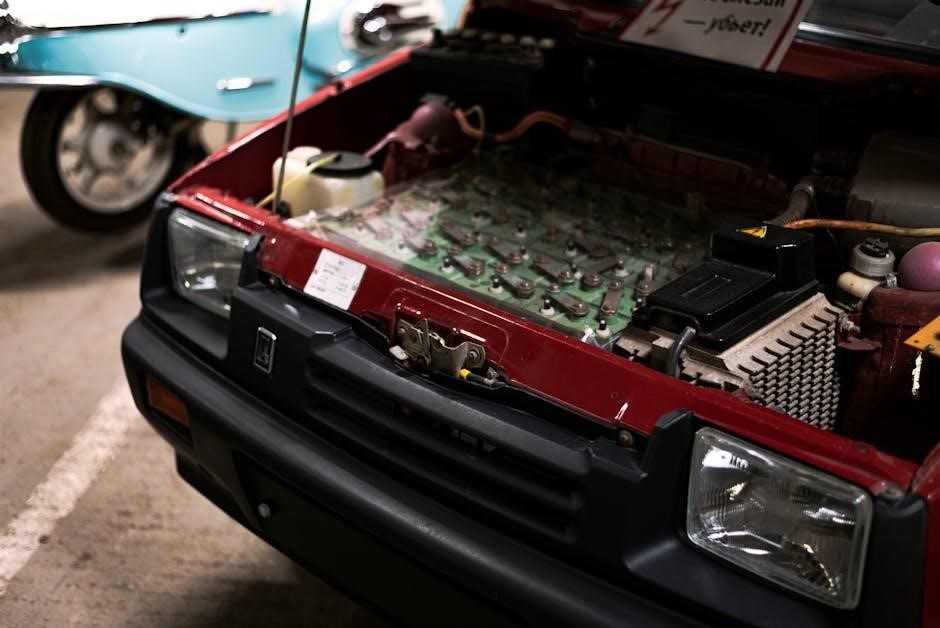
Step-by-Step Installation Guide
Mount the starter enclosure securely‚ connect the main power supply‚ and wire the motor according to the diagram. Ensure all connections are tight and follow safety protocols.
8.1 Mounting the Starter Enclosure
Mount the starter enclosure in a clean‚ dry location with adequate ventilation to prevent overheating. Use screws or bolts to secure it to a flat surface‚ ensuring stability. Align the enclosure with the motor and other components for proper wiring access. Ensure the enclosure is grounded for safety. Follow the manufacturer’s guidelines for specific mounting requirements. Proper installation ensures reliable operation and reduces the risk of electrical faults or damage to the system.
8.2 Connecting the Power Supply
Connect the three-phase power supply to the starter enclosure by following the wiring diagram. Ensure the lines (R‚ S‚ T) are correctly linked to the input terminals of the starter. Verify the voltage rating matches the motor’s specifications. Securely fasten all connections to prevent loose contacts. Connect the neutral and ground wires as per safety standards to ensure proper earthing. Double-check the wiring before energizing the system to avoid electrical hazards and ensure reliable operation.
8.3 Wiring the Motor to the Starter
Connect the motor terminals to the starter’s output terminals as per the wiring diagram. Ensure the motor’s phase wires (U‚ V‚ W) are correctly linked to the starter’s output terminals. Use the appropriate cable size to minimize voltage drop. Verify the phase sequence matches the motor’s nameplate specifications. Secure all connections tightly to prevent overheating. Double-check the wiring for any loose connections or misconfigurations. Finally‚ test the motor operation to ensure smooth rotation and proper phase sequencing before full-load application.
8.4 Final Testing and Commissioning
After wiring‚ perform a final test to ensure the motor and starter function correctly. Use a multimeter to verify continuity and phase rotation. Start the motor and observe its operation for smooth rotation and no unusual noises. Check for proper power distribution and ensure all safety mechanisms are active. Verify overload protection settings and test emergency stop functionality. Document the results and ensure compliance with electrical standards. This step guarantees safe and efficient motor operation‚ minimizing risks of malfunctions or accidents;

Advanced Features and Accessories
Advanced 3-phase motor starters integrate PLCs‚ remote monitoring‚ and energy-saving technologies. These features enhance control‚ efficiency‚ and scalability in modern industrial applications‚ ensuring optimal performance and reliability.
9.1 Programmable Logic Controllers (PLCs) Integration
PLCs integrate seamlessly with 3-phase motor starters‚ enabling advanced automation and precise control. They allow programming of motor start/stop operations‚ speed regulation‚ and monitoring through ladder diagrams. PLCs ensure efficient motor operation by automating sequences and providing real-time feedback. This integration enhances safety by enabling remote monitoring and fault detection. PLCs also support energy efficiency and can be programmed to optimize motor performance. Their flexibility makes them ideal for complex industrial applications‚ ensuring reliable and adaptable motor control systems. PLC integration is a key feature in modern motor starter wiring diagrams for enhanced functionality and control.
9.2 Remote Monitoring and Control
Remote monitoring and control systems enable real-time oversight of 3-phase motor starters via IoT or web-based interfaces. Operators can monitor motor performance‚ receive alerts‚ and adjust settings from any location. This enhances operational efficiency and reduces downtime. Remote systems often integrate with PLCs and HMIs for seamless communication. They also support energy management by tracking consumption and optimizing usage. Advanced features include predictive maintenance alerts and automated responses to anomalies‚ ensuring better safety and reliability in industrial environments. This technology is crucial for modern‚ data-driven motor control systems.
9.3 Energy Efficiency and Smart Starters
Modern 3-phase motor starters incorporate energy-efficient technologies to optimize performance. Smart starters use advanced algorithms to adjust motor speed and torque‚ reducing energy waste. They integrate with sensors for real-time monitoring and adaptive control. These systems minimize power consumption and lower operational costs. Smart starters also support demand response and load management‚ enhancing overall efficiency. By leveraging intelligent controls‚ they reduce environmental impact while maintaining productivity‚ making them essential for eco-friendly industrial applications and energy-conscious industries.
A 3-phase motor starter wiring diagram is essential for efficient and safe motor installation. It ensures proper connections and troubleshooting‚ promoting reliability and minimizing downtime. By following the diagram‚ users can optimize motor performance and adapt to future technological advancements in motor control systems.
10.1 Summary of Key Points
A 3-phase motor starter wiring diagram is crucial for safe and efficient motor installation. It outlines connections for components like contactors‚ overload relays‚ and control circuits. Understanding diagrams ensures proper setup and troubleshooting‚ reducing downtime. Key points include DOL and Star-Delta starters‚ safety practices‚ and advanced features like PLC integration. Following these guidelines helps optimize motor performance and adapt to future technological advancements in motor control systems.
10.2 Future Trends in Motor Starter Technology
Future trends in motor starter technology include the integration of smart starters with IoT connectivity for real-time monitoring and control. Energy-efficient designs and AI-driven diagnostics are expected to enhance performance and reliability. Advanced PLC integration will enable seamless automation‚ while predictive maintenance systems will reduce downtime. These innovations aim to optimize motor control‚ ensuring safer and more efficient operations across industrial applications. Such advancements align with global energy efficiency standards and the growing demand for intelligent industrial solutions.
